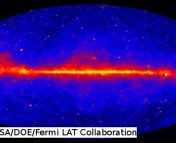 If you’re a long-time astrobites reader with interests that extend to the fascinating and vibrant field of particle physics, you’ll love the work being published at our sister site particlebites. Like astrobites, particlebites authors are graduate students that cover the latest research in their field, particle physics, by posting concise and engaging summaries of newly published research and preprints. Below is an excerpt from a post by particlebites author Flip Tanedo.
If you’re a long-time astrobites reader with interests that extend to the fascinating and vibrant field of particle physics, you’ll love the work being published at our sister site particlebites. Like astrobites, particlebites authors are graduate students that cover the latest research in their field, particle physics, by posting concise and engaging summaries of newly published research and preprints. Below is an excerpt from a post by particlebites author Flip Tanedo.
Theoretical physicists have proposed new theory for how dark matter interactions can explain the observed amount of dark matter in the universe today. This elastically decoupling dark matter framework, is a hybrid of conventional and novel dark matter models.
Presenting: Elastically Decoupling Dark Matter
Authors: Eric Kuflik, Maxim Perelstein, Nicolas Rey-Le Lorier, Yu-Dai Tsai
Reference: 1512.04545, Phys. Rev. Lett. 116, 221302 (2016)
The particle identity of dark matter is one of the biggest open questions in physics. The simplest and most widely assumed explanation is that dark matter is a weakly-interacting massive particle (WIMP). Assuming that dark matter starts out in thermal equilibrium in the hot plasma of the early universe, the present cosmic abundance of WIMPs is set by the balance of two effects:
- When two WIMPs find each other, they can annihilate into ordinary matter. This depletes the number of WIMPs in the universe.
- The universe is expanding, making it harder for WIMPs to find each other.
This process of “thermal freeze out” leads to an abundance of WIMPs controlled by the dark matter mass and interaction strength. The term ‘weakly-interacting massive particle’ comes from the observation that dark matter of roughly the mass of the weak force particle that interact through the weak nuclear force gives the experimentally measured dark matter density today.
Two ways for a new particle, X, to produce the observed dark matter abundance: (left) WIMP annihilation into Standard Model (SM) particles versus (right) SIMP 3-to-2 interactions that reduce the amount of dark matter.





